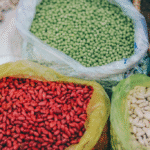Reading food labels helps you understand what you eat. It gives you control over your nutrition. Whether you want to manage weight, reduce sugar, or eat more fibre, food labels show the facts. Knowing how to read them helps you make smart choices every day.
Labels are full of numbers, ingredients, and claims. They may look confusing, but you can learn them step by step.
Once you know what each part means, shopping becomes faster and healthier. Let’s break it down so you can use labels with confidence.
Step 1: Check the Serving Size
Why Serving Size Matters
Serving size is the first thing on the label. It tells you how much of the product all the numbers are based on. If a bag says “serving size: 1 cup” but you eat 2 cups, you need to double all the numbers: calories, fat, sugar, and more.
Pay close attention to how many servings are in the whole package. Some small snacks may look like a single serving but contain two or more. Always match the serving size to how much you plan to eat.
Step 2: Look at Calories
Understand Energy Intake
Calories show how much energy the food gives you. If you want to lose, gain, or maintain weight, calories are key. But don’t just look at the number alone. Think about whether the food is also giving you nutrients.
High-calorie foods with low nutrients (like chips or soda) are less helpful. Foods with fewer calories but more fiber and protein (like vegetables or beans) are more filling and better for your health.
Step 3: Analyze the Fat Content
Good vs Bad Fats
Total fat is listed in grams. It also breaks down into saturated fat and trans fat. Too much saturated fat can raise cholesterol. Avoid trans fat completely. Even if the label says 0g, check the ingredient list for “partially hydrogenated oils.”
Healthy fats, like those from nuts, seeds, and avocados, are better choices. They help your body and can keep you full longer. The key is to stay aware of fat types and amounts.
Step 4: Find Added Sugars
Sugar Facts
Added sugars are extra sugars added during processing. These are not the natural sugars found in fruits or milk. Look under “Total Carbohydrates” for “Added Sugars.”
The lower the added sugar, the better. High sugar intake can lead to weight gain and health issues. Aim for less than 25 grams per day for women and 36 grams for men. Watch for sugar under different names like cane syrup, high-fructose corn syrup, and maltose.
Step 5: Check Sodium Levels
Salt and Health
Sodium means salt. Too much sodium can raise blood pressure and increase heart risk. Many packaged foods add salt for taste and preservation.
Try to keep sodium under 2,300 mg per day. Canned soups, sauces, frozen meals, and snacks are common high-sodium foods. Choose low-sodium or no-salt-added versions when possible.
Step 6: Look for Fiber
Support Digestion and Fullness
Fiber is important for digestion, heart health, and staying full. More fiber can help manage weight because it slows digestion and keeps hunger in check.
Look for products with at least 3 grams of fiber per serving. Whole grains, beans, fruits, and vegetables are top sources. Avoid foods labeled “refined” or “enriched” grains—these have less fiber.
Step 7: Understand % Daily Value (%DV)
How to Use %DV
The % Daily Value tells you how much a nutrient in one serving contributes to your daily diet. It is based on a 2,000-calorie diet, which is a general guideline.
Use it to compare foods. 5% DV or less means low. 20% DV or more means high. Try to get high %DV for fiber, vitamins, and minerals. Keep %DV for saturated fat, sodium, and added sugars low.
Step 8: Read the Ingredient List
Know What’s Inside
Ingredients are listed by weight. The first few items make up most of the food. If sugar, salt, or refined grains are listed first, the product may not be very healthy.
Choose items with simple, whole-food ingredients. Short lists are often better. Avoid foods with many chemical-sounding names or artificial additives.
Step 9: Spot Red Flags
What to Avoid
Some ingredients and numbers signal poor quality. Red flags include:
- Trans fat
- High added sugar
- High sodium
- Artificial sweeteners
- Long ingredient lists with many additives
Avoid these when possible. Instead, pick foods rich in fiber, protein, and nutrients. Look for whole grains, lean protein, and foods with natural colors and flavors.
Step 10: Compare Similar Products
Make Better Choices
Use labels to compare items. One brand of cereal may have twice the sugar of another. Two yogurts may look the same but differ in protein and fat.
Line up products side by side. Look at serving size, calories, fiber, sugars, and ingredients. Small differences can have a big effect over time.
Marketing Claims: What Do They Really Mean?
Decoding the Front of the Package
Phrases like “all natural,” “low fat,” or “made with whole grains” can be misleading. These claims are not always regulated.
Always turn the package around and read the label. “Low fat” may still be high in sugar. “Whole grain” may mean a small amount added to refined flour. Trust the facts on the back.
Tips for Quick Label Reading
Speed Up Shopping
You don’t need to study every label for long. With practice, you’ll spot key details fast. Here’s a quick checklist:
- Check serving size
- Look at calories
- Limit saturated fat and added sugar
- Choose more fiber
- Read ingredients
Keep it simple. Focus on your top health goals—whether it’s less sugar, more fiber, or fewer processed foods.
Final Words
Food labels help you choose better food. Focus on serving size, calories, fats, sugar, sodium, and fiber. Use %DV to compare items and read ingredients for quality.
Avoid red flags like added sugar, trans fat, and high sodium. Choose foods with whole ingredients and good nutrients. Small label-smart choices add up to big health results.
FAQs
What is the most important part of a food label?
Start with the serving size. Then check calories, fat, sugar, sodium, and fiber.
Are all calories equal?
No. Calories from fiber and protein help with fullness. Calories from sugar or fat may lead to overeating.
How can I reduce added sugar?
Avoid sweetened drinks and processed snacks. Choose plain yogurt, fresh fruit, and unsweetened cereals.
What should I look for in bread or cereal?
Look for whole grains, at least 3g fiber per serving, and low added sugar.
Is “natural” always healthy?
No. “Natural” is not a guarantee of health. Always read the full label for real facts.
Why does fiber matter?
Fiber helps digestion, controls blood sugar, and supports fullness. It can help with weight control.


